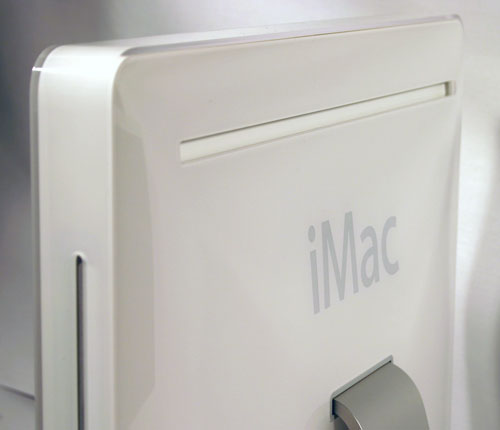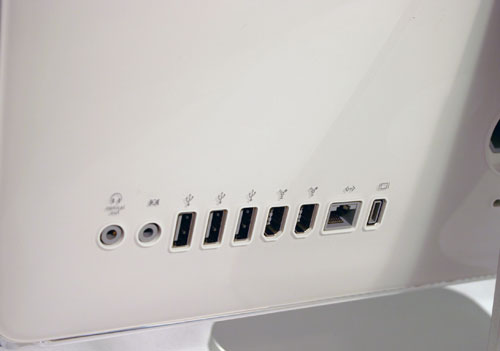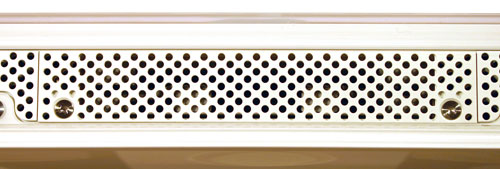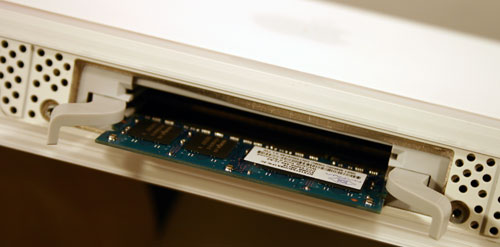Apple Makes the Switch: iMac G5 vs. iMac Core Duo
by Anand Lal Shimpi on January 30, 2006 11:26 PM EST- Posted in
- Mac
The new iMac
 Although my wife has been using one for a while, I realized that I have never actually given my impressions of Apple's iMac platform, despite having looked at both their desktop and notebook offerings in my initial wave of Mac articles.
Although my wife has been using one for a while, I realized that I have never actually given my impressions of Apple's iMac platform, despite having looked at both their desktop and notebook offerings in my initial wave of Mac articles.
The iMac is an interesting option for the desktop user, as it is very much a "lifestyle" computer, but a very functional and capable one at that. The iMac is the epitome of what today's PC makers simply do not create - and that is a modern, stylish take on the desktop computer.
It has been done many times in the past. You combine a monitor with a computer and sell it as one. It was done so frequently and so poorly in the past on PCs that there is now a stigma associated with it, but let's think about that for a moment; some of the worst all-in-one designs came about well before LCD panels became mainstream, not to mention that user upgradability was a much bigger deal back then than it is today. With the advent of the LCD panel, you can actually have some pretty stylish integrated systems, if you design them properly, that is. And the issue of upgradability is far less of a demand today than it was back then for a number of reasons: the rate at which CPUs are released has slowed down tremendously, external storage is extremely easy to add, and if you aren't a gamer, then a good GPU today will last you years to come. The point is that these integrated designs were mostly terrible in the past, but that doesn't mean that they have to be today.
When Apple released the Mac mini, I looked at it and thought that they had struck gold; they basically took a notebook platform, massaged the shape, and stuck it in a wonderful form factor for the casual desktop user. In the process, you lose the ease of internal access that larger form factors would offer, but the end result is very close to the perfect form factor for casual users. With the iMac, Apple has pretty much done the same thing; they've taken a notebook motherboard and processor, although this time combined it with a 3.5" desktop hard drive, and mounted it behind a LCD panel - creating a very elegant desktop computer.
The trick to the iMac is in its form factor - although the design is a little bottom heavy, the iMac doesn't look all that much different than your standard LCD monitor. The very positive side effect of the iMac's integrated design is that when paired with a Bluetooth keyboard and mouse, you only have a single cable coming out of the system for power and that's all. The iMac has made it OK for a computer to be on top of your desk again, with as little as one cable coming out of the system - the days of a wiring nest collecting dust behind your computer are over. Granted, this machine isn't for everyone, and I definitely couldn't use it as my only computer simply because I would need a higher resolution panel attached to it, but as a second or third computer, or a computer for someone who just wants the basics (Web browsing, email, documents, music, photos, movies, etc.), the iMac does suffice.
Apple has done the bare minimum and outfitted these two systems with 512MB of memory. I mention that 512MB is the bare minimum because it honestly is for OS X, but I will mention that one of the first upgrades that I would perform on these machines is to bring them up to 1GB of memory. With only 512MB, there were a number of cases during my normal use of the machines (which, in this instance, didn't include any heavy multitasking) where I found them swapping to disk. Just browsing the web or checking email didn't trigger it, but it was once I started to really use any of the iLife '06 or iWork '06 applications that 512MB quickly became a burden.
Upgrading the memory on the iMac is about the only thing that you can do, as replacing the hard drive requires a complete disassembly of the machine (which isn't something that Apple wants end users to do - they would like you to bring it into their stores for those sorts of upgrades). Thankfully, upgrading the memory on the machine is fairly easy. Along the bottom of the machine, there are two screws that you can remove with a small screwdriver. Removing these screws releases a panel that covers either one or two slots for memory, depending on which iMac you own.
 Although my wife has been using one for a while, I realized that I have never actually given my impressions of Apple's iMac platform, despite having looked at both their desktop and notebook offerings in my initial wave of Mac articles.
Although my wife has been using one for a while, I realized that I have never actually given my impressions of Apple's iMac platform, despite having looked at both their desktop and notebook offerings in my initial wave of Mac articles. The iMac is an interesting option for the desktop user, as it is very much a "lifestyle" computer, but a very functional and capable one at that. The iMac is the epitome of what today's PC makers simply do not create - and that is a modern, stylish take on the desktop computer.
It has been done many times in the past. You combine a monitor with a computer and sell it as one. It was done so frequently and so poorly in the past on PCs that there is now a stigma associated with it, but let's think about that for a moment; some of the worst all-in-one designs came about well before LCD panels became mainstream, not to mention that user upgradability was a much bigger deal back then than it is today. With the advent of the LCD panel, you can actually have some pretty stylish integrated systems, if you design them properly, that is. And the issue of upgradability is far less of a demand today than it was back then for a number of reasons: the rate at which CPUs are released has slowed down tremendously, external storage is extremely easy to add, and if you aren't a gamer, then a good GPU today will last you years to come. The point is that these integrated designs were mostly terrible in the past, but that doesn't mean that they have to be today.
When Apple released the Mac mini, I looked at it and thought that they had struck gold; they basically took a notebook platform, massaged the shape, and stuck it in a wonderful form factor for the casual desktop user. In the process, you lose the ease of internal access that larger form factors would offer, but the end result is very close to the perfect form factor for casual users. With the iMac, Apple has pretty much done the same thing; they've taken a notebook motherboard and processor, although this time combined it with a 3.5" desktop hard drive, and mounted it behind a LCD panel - creating a very elegant desktop computer.
The trick to the iMac is in its form factor - although the design is a little bottom heavy, the iMac doesn't look all that much different than your standard LCD monitor. The very positive side effect of the iMac's integrated design is that when paired with a Bluetooth keyboard and mouse, you only have a single cable coming out of the system for power and that's all. The iMac has made it OK for a computer to be on top of your desk again, with as little as one cable coming out of the system - the days of a wiring nest collecting dust behind your computer are over. Granted, this machine isn't for everyone, and I definitely couldn't use it as my only computer simply because I would need a higher resolution panel attached to it, but as a second or third computer, or a computer for someone who just wants the basics (Web browsing, email, documents, music, photos, movies, etc.), the iMac does suffice.



All of the ports are on the back of the system.
Apple has done the bare minimum and outfitted these two systems with 512MB of memory. I mention that 512MB is the bare minimum because it honestly is for OS X, but I will mention that one of the first upgrades that I would perform on these machines is to bring them up to 1GB of memory. With only 512MB, there were a number of cases during my normal use of the machines (which, in this instance, didn't include any heavy multitasking) where I found them swapping to disk. Just browsing the web or checking email didn't trigger it, but it was once I started to really use any of the iLife '06 or iWork '06 applications that 512MB quickly became a burden.
Upgrading the memory on the iMac is about the only thing that you can do, as replacing the hard drive requires a complete disassembly of the machine (which isn't something that Apple wants end users to do - they would like you to bring it into their stores for those sorts of upgrades). Thankfully, upgrading the memory on the machine is fairly easy. Along the bottom of the machine, there are two screws that you can remove with a small screwdriver. Removing these screws releases a panel that covers either one or two slots for memory, depending on which iMac you own.


The 200-pin DDR2 SO-DIMM in the Intel based iMac.










35 Comments
View All Comments
snookie - Friday, February 3, 2006 - link
The article is very good but surprisingly makes the same mistake as so many other reviews which is to test with only 512MB of ram. The intel imac is a much better machine with more ram and it doesn't make sense to test it with the minimum amount. Also Universal apps are coming fast and furious on a daily basis. I've got 1.5 GB of ram in mine and lots of the little apps I use everyday are already UB and are nice and fast as is the OS and iLife apps. It won't be long before Windows runs on these as well as Linux with Red Hat promising support. Check out Bare Feats for some pretty nice benchmarks including games. Yes, Quake 4 will actually run at a decent speed as well as COD 2.http://www.barefeats.com/imcd.html">http://www.barefeats.com/imcd.html
csoto - Friday, February 3, 2006 - link
Your only complaints stem from poor choice of models/configuraitons. The 20" unit will provide the added resolution, and BTO options allow up to 2GB on the Core Duo and 2.5GB on the G5 (although a 2GB soDIMM is listed at >$1K!). This is like me complaining that my mini van doesn't have a navigation system, because I was too cheap to buy the model that came with it :)Also, your assertion that the Core Duo is a "public beta" is absurd. You had zero problems running applications. Word from those around me that are testing Core Duos is that for most applications, you don't even notice Rosetta. Pro Apps users would complain, but they're never early adopters, because their apps always lag at least a few months behind the latest platform (remember the "multiprocessor plug-in" that allowed Photoshop to limp along for so long before a "MP-native" version was released?). This is a solid platform transition, likely exceeding the fairly solid (albeit far more daunting for the day) transition from 680x0 to PPC.
Now if only VMWare would ship Workstation for Mac OS X, then I could ditch the Dell...
Charles
Furen - Sunday, February 5, 2006 - link
He says he already had an iMac so in order to compare the two I'm guessing he bought the closest-matching one possible. I would hardly do to have an 20" iMac compared with a 17" one in power consumption or running at a different native resolution. I do agree that the RAM limits the system insanely but he went for default specs rather you start improving all the draw backs each system has.The reason why he says this is like a public beta is not because Rosetta sucks or anything of the sort but because there are almost no universal binaries besides those shipped by Apple. Apple chose to bring these systems forwards (at first they had said the systems would come out mid '06, I believe) without having enough of a software base and that's a pretty big drawback.
jepapac - Wednesday, February 1, 2006 - link
I was just wondering if the graphics adapter on the iMac is upgradeable since it is using pciexpress. Does anyone know?aliasfox - Thursday, February 2, 2006 - link
I'm guessing its actually the laptop X1600 in the iMac, soldered onto the motherboard. Unfortunate, yes, but given the primary audience that the iMac is targeted at, I'm not surprised.Your average home user would rather buy a new $600-1000 box instead of dropping ~$500 for more RAM, a bigger hard drive, new graphics, and a faster processor.
Eug - Thursday, February 2, 2006 - link
Why? Previous iMacs used desktop GPU parts.
aliasfox - Thursday, February 2, 2006 - link
I read somewhere that the 9600 in the second generation iMac G5 was a laptop part, and I therefore assumed that since Apple used the same GPUs in the iMac that it used in PowerBooks (GeForce FX5200, Radeon 9600, X1600), it was sourcing the same parts for both lines.Also, I've never read about an integrated 9600 or FX5200 as a desktop part. I might be mistaken though.
nizzki - Tuesday, January 31, 2006 - link
Any idea which compilers apple has used for their apps? For example, for the PPC apps I assume apple uses the IBM compiler heavily optimized for PPC instead of GCC.If that is the case, with the intel compiler for osx is in beta, the current somewhat lackluster performance of the core duo might be skewed in PPC's favor. This would be further exacerbated if Apple used GCC to compile the macintel apps, since it is unlikely to be heavily optimized for the core duo architecture.
Commodus - Tuesday, January 31, 2006 - link
Just a heads-up, Anand: the Core Duo iMac is the first iMac model to support desktop spanning, not just mirroring. So if you want, you can hook up even a 23" Cinema Display and get a huge amount of extra workspace. I'd probably only do that with a 20" iMac and the 256 MB video memory option, though.ingoldsby - Tuesday, January 31, 2006 - link
Perhaps it's just me, but the non native apps I run seem to run at about the same speed as they natively ran on my G5. While the universal binaries run much faster.I would love to see this comparison revisited with a realistic amount of memory in the machine (ie. 1gb+) instead of limiting the machine to 512mb.